Android fragmentation: There are now 24,000 devices from 1,300 brands


Samsung may be the biggest seller of Android devices, but it's far from alone: there are now 1,300 brands behind the one billion Android handsets now in use across the globe.
OpenSignal, the maker of an app that gauges mobile signals, has released its fourth annual Android fragmentation report which found a total of 24,093 different Android devices now in the wild, made by 1,294 companies.
It's a vastly different picture to 2012: 1,000 of the brands that appear in this year's survey didn't exist three years ago. Now, there's a growing number of Android device makers both large and small, chipping away at Samsung's dominance and chasing the small slice of the industry's profits that aren't held by Apple.
OpenSignal notes that Samsung's share of the Android market has declined from 47 percent in 2012 to 37.8 percent in 2015. Over those two years the number of Android devices has more than doubled from 11,868 in 2013 to today's 24,093.
Some of the brands making a bigger splash this year include Xiaomi, Oppo, OnePlus, ZTE, and Huawei, alongside the more established OEMs, such as LGE, Lenovo, Sony and HTC.
While the number of new OEMs has grown sevenfold over the past three years, OpenSignal's data also shows the rate of growth has tapered off, with around 400 new brands introduced in 2012 compared to fewer than 100 this year. That comes as the smartphone divisions from Sony, Samsung, LG, and HTC struggle to turn a profit.
The fragmentation Android has become known for though is on the operating system front, thanks to different handsets not being upgraded to the latest version of Android. Google been dealing with operating system fragmentation via Google Play Services to ensure core apps are kept up to date, but OpenSignal notes it still remains "extremely fragmented" despite a slight reduction in fragmentation over the past year.
According to Google's latest figures, KitKat 4.4 and Jelly Bean (4.1.x to 4.3) remain the most widely used versions of Android, followed by Android 5.0 Lollipop.
Read more on Android